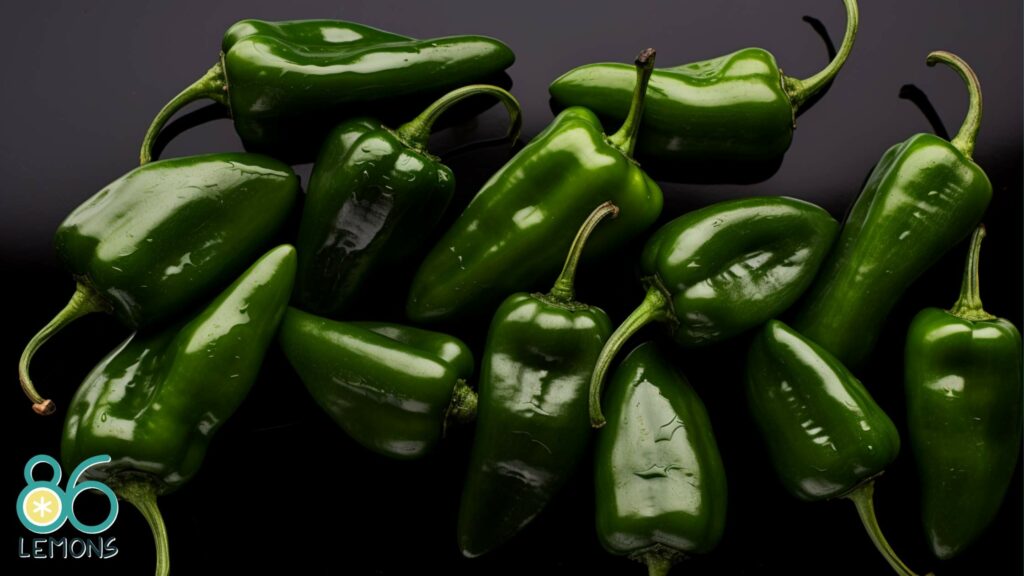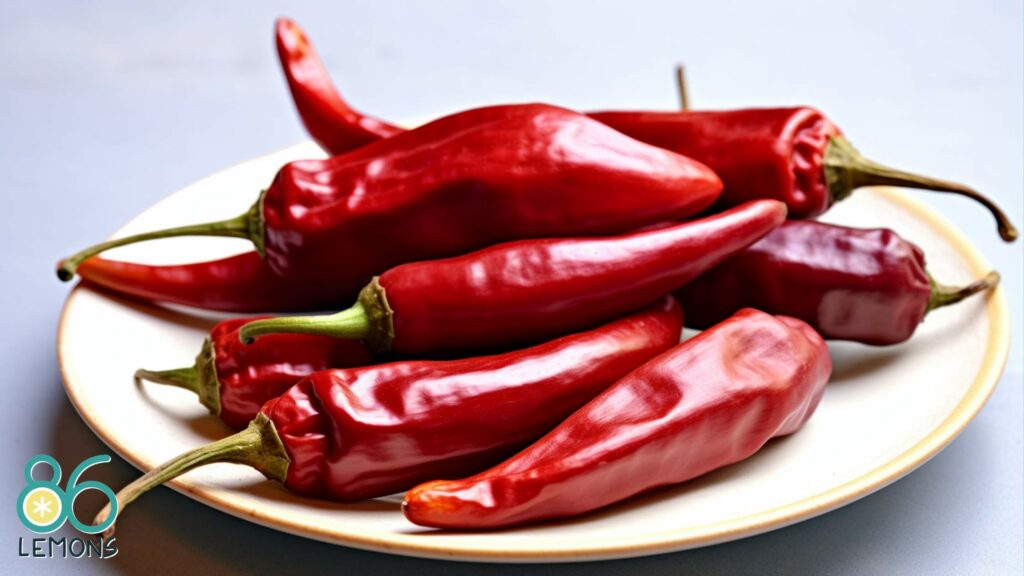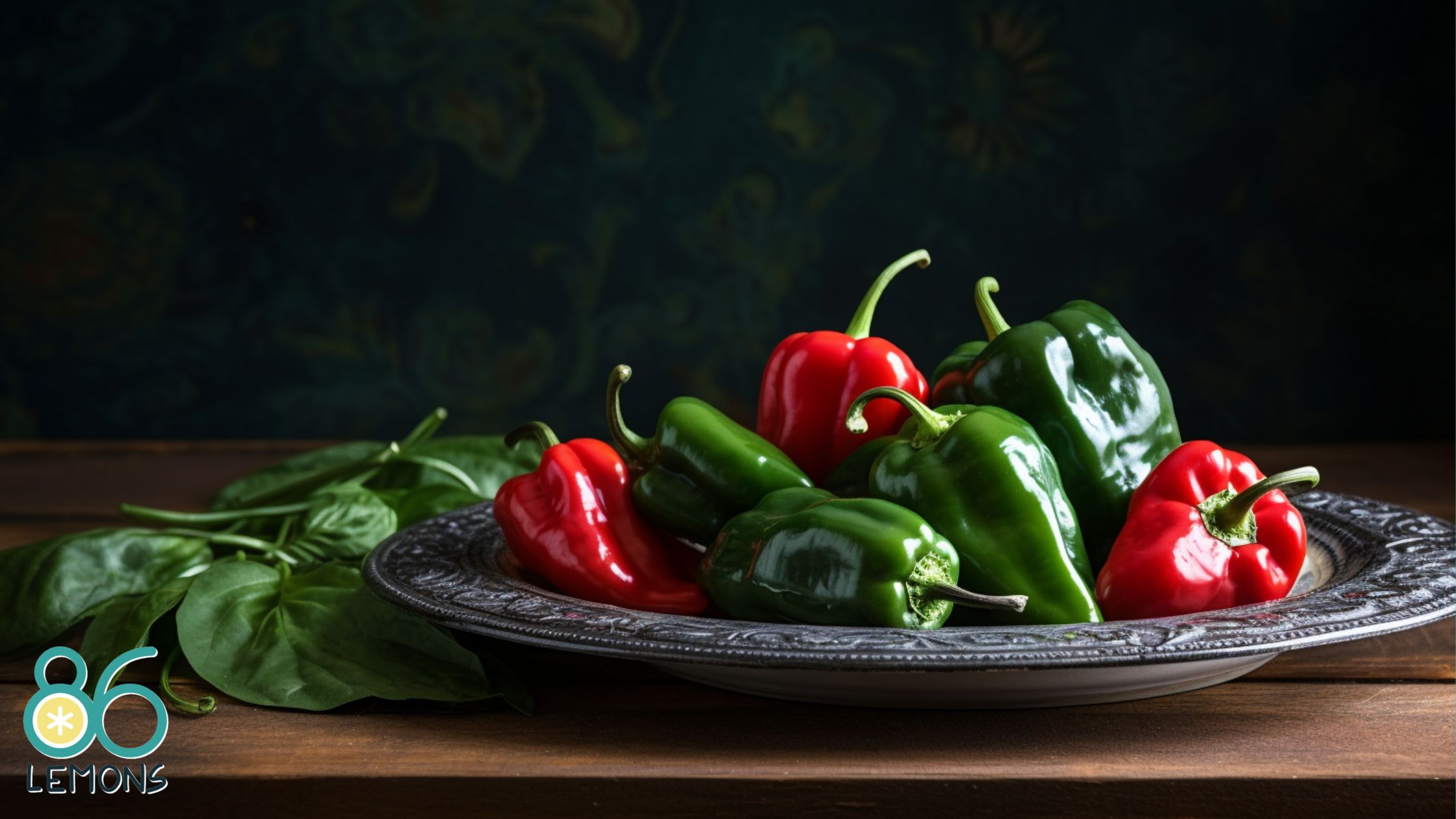I love cooking with poblano peppers! They bring a perfect blend of earthy flavor and mild heat to various dishes from my vegan cookbooks. However, there might be times when I can’t find these fantastic peppers at my local grocery store, or I simply want to experiment with alternative options. Luckily, there are several great substitutes for poblano peppers that can easily be incorporated into recipes.
It’s essential to understand the essence of poblano peppers to find the most suitable substitutes. Poblano peppers have a unique combination of flavor, heat, and versatility that makes them ideal for various dishes such as chili rellenos, salsa, or stuffed peppers.
With this in mind, I’ve selected some top substitutes for poblano peppers and evaluated their heat profiles, ensuring that alternatives provide a similar culinary experience.
Key Takeaways
- Poblano peppers offer a fantastic balance of earthy flavor and mild heat, but substitutes are available.
- Top substitutions for poblano peppers need to have similar flavor, heat, and versatility characteristics.
- Understanding unique pepper variants helps in selecting the best poblano pepper substitutes for your dishes.
The Essence of Poblano Peppers

Characteristics of Poblano Peppers
Poblano peppers are amazing peppers that are shiny dark green and usually grow to be about 4 inches long and 2 inches wide. One of their most exciting features is their thick walls, which makes them perfect for stuffing in dishes like chiles rellenos. In terms of flavor, poblanos are mildly spicy and have a rich, earthy taste that truly sets them apart from other peppers.
Role in Mexican Cuisine
When it comes to Mexican cuisine, poblano peppers hold a special place in my heart. They play a crucial role in numerous dishes, and their unmistakable flavor leaves everyone wanting more.
Some dishes that feature poblano peppers include chiles en nogada, which pairs the peppers with a creamy walnut sauce, and rajas con crema, where poblano strips are mixed with creamy sauces and other delicious ingredients. I simply adore how poblano peppers infuse Mexican recipes with a unique taste, aroma, and texture.
Scoville Heat Units of Poblano
So, how spicy are poblano peppers? To give you an idea, we can refer to the Scoville Heat Units (SHU), a scale that measures the spiciness of peppers. Poblano peppers range from 1,000 to 2,000 SHU, which places them on the milder end of the spice spectrum. To put that into perspective, here’s a comparison with other peppers:
| Pepper | Scoville Heat Units |
|---|---|
| Bell Peppers | 0 SHU |
| Poblano Peppers | 1,000 – 2,000 SHU |
| Jalapeno Peppers | 2,500 – 8,000 SHU |
| Habanero Peppers | 100,000 – 350,000 SHU |
Despite their comparatively mild heat, poblano peppers still pack a flavorful punch that makes them a cherished ingredient in many dishes. I can’t imagine Mexican cuisine without the essence of poblano peppers!
Top Substitutes for Poblano Pepper
Anaheim Pepper: A Mild Alternative
Anaheim peppers are a fantastic substitute for poblano peppers! They have a similar appearance and can be used in the same way. Although they’re a bit spicier than poblanos, their taste and texture still make them perfect for many recipes. They’re especially ideal when you’re looking for a mild yet flavorful alternative!
Bell Pepper: Sweet and Versatile
Another substitute I highly recommend is bell pepper, particularly the green bell pepper. Their rich flavor resembles that of poblano peppers, but they’re a bit sweeter and milder, which makes them a versatile option when you don’t want to add too much heat to your dish. From red to orange and yellow, feel free to experiment with an array of bell pepper colors to find your favorite taste and sweetness level!
Jalapeño Pepper: A Spicy Twist
For those who crave an extra kick, let me introduce you to jalapeño peppers! Though they may not be the first substitute that comes to mind, jalapeños can truly add a spicy twist to your dish as a poblano pepper alternative. Keep in mind that they’re smaller in size, so make sure to adjust the quantity accordingly. But if it’s that exciting heat you’re after, jalapeños are sure to deliver the perfect punch!
Advanced Substitution Options

Guajillo Pepper: Complex Flavors
One option I’m really excited about for substituting poblano peppers is the Guajillo pepper! These peppers offer a complex flavor profile, bringing a mix of sweetness, tanginess, and earthy undertones to your dish. To use guajillo peppers in place of poblanos, consider the following adjustments:
- Quantity: Use 1 Guajillo pepper for every two poblano pepper in the recipe.
- Heat level: Guajillo peppers are moderately spicy (2,500 to 5,000 SHU), so you might want to adjust the amount of other spices accordingly.
Serrano Pepper: For the Heat Seekers
If you’re looking for something spicier, the Serrano pepper is an excellent choice! These peppers pack a real punch (10,000 to 23,000 SHU) and add a vibrant green color to your dishes. Here’s how you can use them as a poblano pepper substitute:
- Quantity: Use 1 Serrano pepper for every 3 to 4 poblano peppers in the recipe. Remember, they’re much spicier, so adjust the quantity to your taste.
- Preparation: Either chop finely or blend the Serrano pepper to make your dish evenly spicy.
Cayenne Pepper: Intense and Fiery
Last but not least, the Cayenne pepper is a fantastic option for those who aren’t afraid of some intense heat! Cayenne peppers are incredibly fiery (30,000 to 50,000 SHU) and add a bold, sharp flavor to your dish. Here’s how to use them as a poblano pepper substitute:
- Dried cayenne pepper: Use 1/4 to 1/2 teaspoon for every poblano pepper in the recipe.
- Fresh cayenne pepper: Use one fresh cayenne pepper for every two poblano pepper in the recipe.
Please note that since Cayenne peppers are much spicier, it’s essential to adjust the quantity to your liking and tolerance. Enjoy experimenting with these advanced substitution options in your recipes!
Unique Pepper Variants and Their Heat Profiles
Chipotle Pepper: Smoky Depth
Chipotle peppers bring great flavor to any dish! These peppers are actually jalapeños that have been dried and smoked, resulting in a deep, earthy flavor with a heat profile that’s noticeable but not overpowering. Their Scoville Heat Units (SHU) range from 2,500 to 8,000, giving them a medium heat level. Perfect for adding a smoky flair to salsas, sauces, or chili!
Banana Pepper: Mild and Tangy
When you’re looking for a milder option with a bit of a tangy kick, banana peppers are the ideal choice! These bright yellow peppers have a curved shape, resembling a banana – hence the name. With a SHU range of 0 to 500, they’re practically heat-free.
I enjoy them when I’m craving a mild stuffing pepper or a delightful addition to salads and pizzas. Banana peppers offer a versatile, flavorful option without turning up the heat.
Ancho Chili Pepper: Rich and Mild
Ancho chili peppers have a truly unique flavor profile that I can’t help but adore. These are actually dried poblano peppers, and their transformation results in an intense, rich flavor that’s both sweet and a bit earthy.
Ancho peppers are often used in Mexican cuisine, especially in mole sauce! With a heat profile of 1,000 to 2,000 SHU, they’re relatively mild. If you’re interested in adding a bold flavor to your dishes without scorching your taste buds, ancho chilies are the way to go!
These three pepper varieties each have their own distinct heat profiles and flavor characteristics. Whether you’re seeking smoky depth with chipotle peppers, a tangy kick from banana peppers, or the rich, mild intensity of ancho chilies, there’s a pepper for every palette and occasion.
Specialty Peppers for Enthusiasts
As a pepper enthusiast, I’m always excited to explore unique substitutes for poblano peppers. In this section, I’ll introduce you to three specialty peppers that serve as fantastic alternatives for poblanos: New Mexico chiles, Mulato chile peppers, and Habañero peppers. Each of these peppers offers a distinct flavor and heat level, making them worthy additions to your culinary adventures.
New Mexico Chiles: A Stately Flavor
New Mexico chiles are an interesting option for those looking to spice up dishes with a stately and mild flavor. Well-known for their use in New Mexican cuisine, these chiles offer a heat level that ranges from mild to moderately hot. These peppers are often available in both fresh and dried forms, making them a versatile ingredient.
The flavor profile of New Mexico chiles includes:
- Mild sweetness
- Earthy undertones
- Slight fruitiness
I find using New Mexico chiles as a poblano substitute particularly enjoyable in salsas, stews, and chili recipes.
Mulato Chile Pepper: Sweet and Smoky
If you’re interested in a sweet and smoky flavor, Mulato chile peppers might be the perfect alternative for you. These peppers are cousins of the poblano, and their sweet, smoky flavor makes them stand out among pepper varieties.
The Mulato chile pepper offers:
- Rich, earthy taste
- Pleasant smokiness
- Chocolatey undertones
In my experience, using Mulato chile peppers as a substitute for poblanos works exceptionally well in mole sauces and other slow-cooked dishes.
Habañero Pepper: Fiery Flavor
For those who crave a more extreme heat level, the Habañero pepper is an exciting option. This pepper is significantly spicier than the poblano, and it adds a bold, fiery flavor to any dish.
Habañero peppers are known for their:
- Intense heat (up to 350,000 Scoville units)
- Fruity and citrusy taste
- Bright, vibrant color
Be cautious when substituting Habañero peppers for poblanos, as their extreme heat can easily overpower a dish. However, if you’re seeking a daring poblano substitute for salsas, marinades, or hot sauces, the Habañero pepper could be the ideal choice for you!
Harnessing Pepper Substitutes in Cooking

Chile Relleno: Exploring Substitutes
I love experimenting with new ingredients, and when it comes to Mexican cuisine, chile relleno is an all-time favorite. Lucky for me, there are many substitutes for poblano peppers that work perfectly in this traditional dish.
One great option is the Anaheim pepper, which has a similar appearance and heat level. For those who prefer a milder option, green bell peppers also make an excellent substitute, with their rich flavor and resemblance to poblano peppers.
Cooking with Dried Chilies
Dried chilies can be a fantastic alternative to fresh poblano peppers, particularly in recipes that call for a deeper, smoky flavor. Ancho chilies are actually dried poblano peppers and can often be found in Mexican recipes such as tasty mole sauce.
It’s worth noting that some dried chilies can be spicier than poblano peppers, like the cayenne pepper, so always make sure to adjust the amount accordingly to match your heat preference.
Pepper Pairings in Dishes
When I cook, I like to get creative with combining different substitutes for poblano peppers in my dishes. For example, by using a combination of jalapeño peppers and banana peppers in a recipe, I can strike a balance between spicy and mild flavors.
It’s also a great way to create a more complex taste profile. Just keep in mind that jalapeños are spicier and smaller than poblanos, so adjust the quantities accordingly.
In summary, incorporating various substitutes for poblano peppers in Mexican dishes and beyond allows me to explore new flavors and textures while still staying true to the original dish. So, next time you’re in the kitchen, get excited and give these poblano pepper substitutes a try!
READ NEXT: Best Sweet Potato Cutters: Top Picks for Easy Slicing in 2024
Final Thoughts

In my quest to find the perfect poblano pepper substitute, I discovered a variety of options to add that much-needed flavor and spice to my dishes. It’s amazing how the world of green chili peppers offers such diversity and excitement!
One of my top choices has to be the Anaheim pepper, with its similar appearance and slightly spicier taste. It’s great for recipes that require some extra kick. Another fantastic option is the New Mexico chili, available both fresh and dried, which can add a unique touch to my dishes.
For a milder taste, I adore using green bell peppers as a substitute. Their bright color and sweet flavor work well in a variety of recipes. On the other hand, when I’m craving some serious heat, I turn to the Serrano pepper, which really brings excitement to my dishes.
Last but not least, the Cubanelle pepper adds its distinct touch to any dish, with a slightly sweet, tangy flavor that makes it one of my top picks.
So, these are just a few awesome poblano pepper substitutes that I’ve found:
- Anaheim Pepper: similar appearance, spicier taste
- New Mexico Chili: unique flavor, available fresh and dried
- Green Bell Pepper: mild and sweet taste, vibrant color
- Serrano Pepper: seriously hot, adds excitement to dishes
- Cubanelle Pepper: slightly sweet and tangy flavor
I can’t wait to experiment even more with these fantastic green chili alternatives, and I’m confident that my dishes will never be dull again!
Liked this article? Check out this article about parsley substitutes next!


